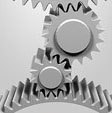| Quenching Quenching is the rapid cooling of steel from a suitable elevated temperature. The quenching process is one of the major operations that influences the microstructure, hardness, mechanical properties and residual stress distribution, assuming the gear has been properly heated before the quench. The preferred microstructure after quenching is primarily martensite. The designer’s or heat treater’s responsibility is to select the quench variables to obtain the required properties in the gear. The quench needs to be fast enough to avoid secondary transformation products, but slow enough to reduce distortion and avoid cracking. The material hardenability will determine how severe the quench has to be for a particular part geometry. Quench cracks usually originate at sharp corners or substantial section size changes. However, even with perfectly uniform sections, parts can easily crack if made of high-carbon, high-hardenability steels and the quench is too severe. Delayed quench cracks can occur hours or days after quenching, especially if improperly tempered or stress relieved. It is good practice to immediately temper after quenching if quench crack problems are a concern. The main factors which control the quench rate are: part geometry, type of quenchant, degree of agitation and quench temperature. The geometry will affect how quickly and uniformly the quenchant will circulate around the part. Pockets which trap vapor bubbles and restrict the flow of quenchant should be avoided. There are a variety of quenchants to choose from such as: oil, polymer, molten salt, water, brine and gases. Each variety is available with a wide range of quench characteristics. Agitation is externally produced movement of the quenchant past the part. The degree and uniformity of agitation greatly influences its rate of heat removal. Agitation can be provided by propellers or pumps in the quench tank or by moving the parts through the quenchant. The temperature of the quenchant may affect its ability to extract heat. Each quenchant should be used within its appropriate range of temperature. The temperature of a water quenchant is more critical than that of an oil.
Remember to bookmark this web site for your future convenience! |
